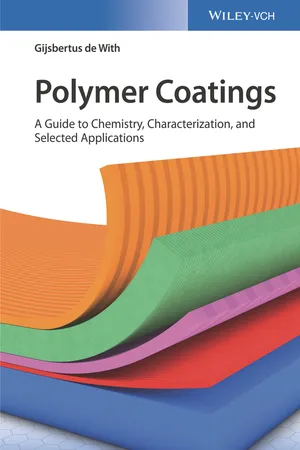
Polymer Coatings
A Guide to Chemistry, Characterization, and Selected Applications
- English
- ePUB (mobile friendly)
- Available on iOS & Android
Polymer Coatings
A Guide to Chemistry, Characterization, and Selected Applications
About This Book
A practical guide to polymer coatings that covers all aspects from materials to applications
Polymer Coatings is a practical resource that offers an overview of the fundamentals to the synthesis, characterization, deposition methods, and recent developments of polymer coatings. The text includes information about the different polymers and polymer networks in use, resins for solvent- and water-based coatings, and a variety of additives. It presents deposition methods that encompass frequently used mechanical and electrochemical approaches, in addition to the physical-chemical aspects of the coating process. The author covers the available characterization methods including spectroscopic, morphological, thermal and mechanical techniques.
The comprehensive text also reviews developments in selected technology areas such as electrically conductive, anti-fouling, and self-replenishing coatings. The author includes insight into the present status of the research field, describes systems currently under investigation, and draws our attention to yet to be explored systems. This important text:
• Offers a thorough overview of polymer coatings and their applications
• Covers different classes of materials, deposition methods, coating processes, and ways of characterization
• Contains a text that is designed to be accessible and helps to apply the acquired knowledge immediately
• Includes information on selected areas of research with imminent application potential for functional coatings
Written for chemists in industry, materials scientists, polymer chemists, and physical chemists, Polymer Coatings offers a text that contains the information needed to gain an understanding of the charaterization and applications of polymer coatings.
Frequently asked questions
Information
1
Introduction
1.1 Scope
1.2 The Importance of Polymer Coatings
Table of contents
- Cover
- Table of Contents
- Dedication
- Preface
- Acknowledgments
- List of Most Important Symbols and Abbreviations
- Chapter 1: Introduction
- Chapter 2: Polymers and Network Characteristics
- Chapter 3: Thermoset Resins
- Chapter 4: Basic Coating Formulations
- Chapter 5: Additives and Particulates
- Chapter 6: Application Methods
- Chapter 7: Physical–Chemical Aspects
- Chapter 8: Chemical and Morphological Characterization
- Chapter 9: Thermal and Mechanical Characterization
- Chapter 10: Rheological Aspects
- Chapter 11: Appearance
- Chapter 12: Electrically Conductive Coatings
- Chapter 13: Marine Anti‐fouling Coatings
- Chapter 14: Self‐replenishing and Self‐healing Coatings
- Chapter 15: What's Next
- Appendix A: Units, Physical Constants, and Conversion Factors
- Appendix B: Data
- Index
- End User License Agreement